Last Updated on April 22, 2023
When a female dog (dam) gives birth to her puppies, that’s what you call whelping.
Most mother canines are capable of delivering their litter without any help, but if you’re a breeder or you have a girl pet, it’s good practice to know the whelping process so you can assist the mommy pooch if needed.
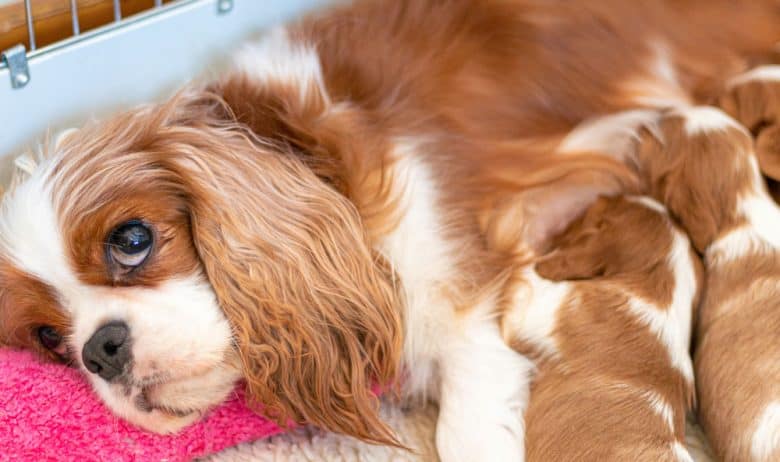
From creating a cozy whelping area to navigating common birthing problems, keep reading for a detailed guide on what to do when whelping puppies.
Quick Navigation
What should I do to prepare for whelping?
The whelping process can be divided into three stages and can generally last around 48 hours.
If it’s your dog’s first litter, your goal is to aim for zero issues and live puppies. Apart from some minor discomfort, this is achievable.
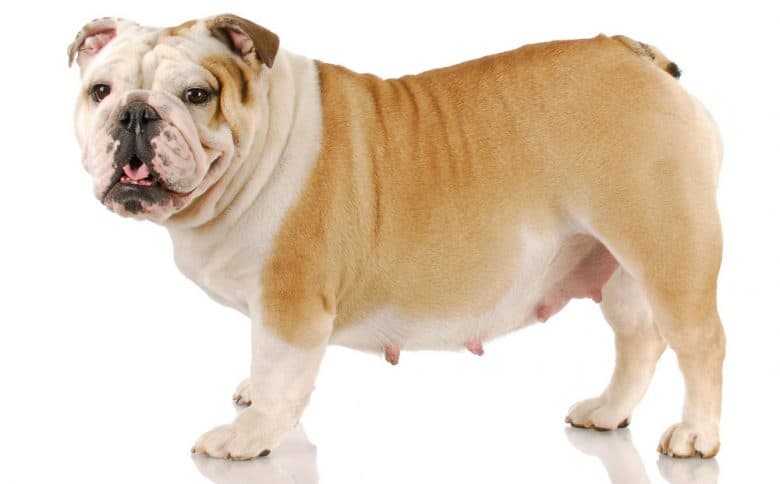
How long labor lasts will depend on different dog breeds. Some female dogs want to be left alone during parturition, while others are more comfortable having their human around. Some fidos even nest close to their owner.
Whichever your pooch prefers, respect her wishes. You can keep checking on her but avoid interfering more than necessary, and that includes while and after giving birth.
Checklist to Get Ready: What you need for whelping puppies?
An X-ray at around 55 days after breeding your dog can tell you how many puppies to expect so you can better prepare for it.
When your dog is a few short weeks away from giving birth, there are some steps you can take to ensure a successful whelping experience.
Understandably, there will be some concerns, such as how you will prepare for puppies and what supplies you will need for whelping and raising a litter.
Thankfully, you only need one simple thing to point you in the right direction — a whelping checklist — for all the items required for whelping puppies.
To help you get started, we’ve curated one just for you!
1. A whelping box – this is the “nest” where your dog will retreat to when it’s time to give birth.
Newborn puppies will spend the first 20 days of their lives in this box, where they can stay warm and protected in a contained space.
You can buy a pre-made whelping box online or make a DIY whelping box from a sturdy cardboard box. See the video down below for a guide on how to make your own:
2. A whelping mat – A whelping mat or pad serves as a clean, non-slip whelping area to prevent liquids from soaking through and provides an insulated surface for the newborn puppies’ comfort.
3. A digital thermometer – Start taking your dam’s temperature 10-14 days before the expected due date. When her temperature drops to 98-99 degrees Fahrenheit, the first pup will usually arrive within 24 hours.
4. A heat source – Newborn puppies are not yet able to regulate their own body temperature.
They usually cuddle up to the mother or each other for warmth. You can use a heating pad, heat lamp, or hot water bottle to keep them warm.
5. An indoor/outdoor thermometer – After all the puppies are born, keep the whelping box heated between 85 to 90 degrees Fahrenheit.
Lower the temperature to 80 degrees after the first week. After the first month, new puppies will be able to regulate their body heat better.
6. A baby scale – Weigh your puppies every day to make sure they’re gaining weight from day one.
7. Whelping supplies:
- Sterile lubricating jelly – “Personal lubricant” for taking the mother’s rectal temperature or if a puppy gets stuck in the birth canal.
- Hemostat – For clamping the umbilical cord once the puppy is born.
- Emergency supplies – Scissors, antiseptic solution, heavy thread, or dental floss.
- A separate whelping box or laundry basket – Line this box or basket with a covered heating pad and blanket to keep puppies in after birth.
8. Cleaning supplies:
- Anti-bacterial wipes and paper towels – To keep yourself and the area clean at all times.
- Hand sanitizer – To keep your hands clean during and after the whelping.
- Alcohol prep pads – To keep equipment clean after each use.
- Iodine prep pads – For cleaning around the area where you cut the umbilical cords.
- Receiving clothes or clean towels – Large litters may need 2-3 dozen clean towels.
- Pee pads – Put underneath the mother during birthing to catch afterbirth.
- Disposable plastic gloves – To wear during the whelping process.
- Garbage can – For easy disposal of any waste.
Stages of Dog Labor: What to expect during whelping?
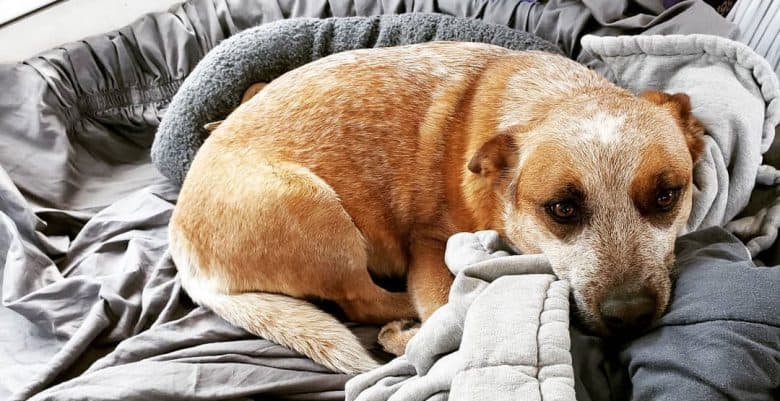
In most cases, your dog will know when the time for labor is drawing near. In the last week, between 2 to 4 days before whelping, she’ll become restless.
During this time, she’ll look for a quiet and secluded space where she can give birth.
If you’ve already prepared the box and introduced her to it, she will hopefully be comfortable enough to settle down there to whelp.
Check the dam’s temperature regularly at this point. Once it drops, the three stages of the whelping process start.
The first stage of labor
During the first stage of labor, the dam will be preparing for her puppies to come out. She’ll be restless, anxious and may pace the room a lot, refuse to eat, or even vomit.
She’ll be hiding in her nest or whelping box when labor is approaching.
If she has decided to start whelping in your bedroom, let her continue as this is her chosen place. Make sure to cover the area with a plastic sheet and plenty of towels, blankets, or shredded newspaper.
As time progresses, a watery vaginal discharge is a signal that her cervix is opening.
The second stage of labor
This is where your dog will begin to deliver her puppies. You will notice visible contractions and panting or yelping, but this shouldn’t last more than 1 to 2 hours.
They’ll start weak and intermittent and will gradually become strong contractions as the labor progresses.
Her vaginal discharge during this stage will be either clear, red, or green — all of which are normal.
Ensure your dog’s bedding and toys are clean, and add them to the nesting space to make her feel more comfortable before giving birth.
The process should go smoothly, but it’s good to have help on standby to keep her calm if there are any complications.
One example is your dog pushing for too long or so hard that the contractions no longer come naturally.
Feathering or manually inducing contractions for a struggling dam can help get the puppies out.
Get gloved and insert a lubricated finger in the birth canal as deep as you can and stroke inside on the top, beneath the spine and tail area, in a “come here” motion.
If she’s in labor and has been experiencing contractions, this will bring them on harder.
Another scenario is a puppy getting stuck in a breech position, where the tail and hindlegs are emerging first. Use lubricant on gloved hands to help pull the puppy out. If not, this may require a c-section.
Several conditions may cause a pregnant dog to experience early labor before completing the 58-day gestation period, such as their dog breed, health history, environment, or malnutrition.
Look for the following symptoms and warning signs your dog can go into premature labor:
- A drop in temperature
- Vomiting
- Loss of appetite
- Excessive barking
- Bloody discharge or tissue
- Clinginess or attention-seeking
The third stage of labor
Once a puppy emerges from the birth canal, it’s generally born within 10 minutes. Each puppy is enclosed in a thin sac or membrane that forms part of the placenta or after birth.
This sac typically breaks during the birthing process and passes through the vulva after the dam gives birth to each puppy.
Around 15 minutes after giving birth, the dam will deliver the placenta or afterbirth and will often eat it. It’s not something nutritious to her, but the hormones in it help with milk production.
However, it may upset her digestive system if she consumes too much of it, so you could choose to discard it.
When the Mother Needs Help
If a puppy is born with the sac still intact and the mother doesn’t lick it off, you should intervene. The puppy has a “grace period” of up to 6 minutes within the sac while it’s still intact before it needs to breathe.
Give the mother a minute, but if it’s not removed after this time, the puppy will suffer either brain damage or death.
You’ll see that the puppy is still attached to a mass of black-green tissue, the afterbirth, via the umbilical cord.
If the mother doesn’t chew through the cord herself, use a sterilized pair of scissors to cut it an inch away from the pup’s tummy. Use the thread or dental floss to tie the cord between ¼ to ½ inch from the puppy’s body.
After removing the membrane and detaching the umbilical cord, the next step is for the mom to lick and clean the newborn puppy.
If she doesn’t do it herself, take a clean towel and rub the puppy until it’s clean and dry. This will stimulate them to start breathing.
How do I look after the puppies?
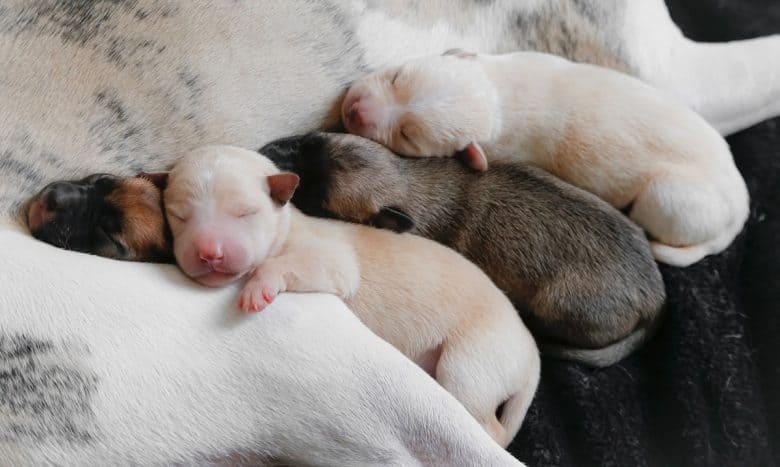
While the mother births the rest of the litter, the first puppy is already enjoying a hot milky meal! Newborn puppies cannot walk but will instinctively scoot on their bellies to find their mother’s milk.
They’ll spend most of their time sleeping but will wake every few hours to nurse. You should check upon them to make sure they are warm and getting enough milk.
As they grow, the intervals in between feedings will increase. Once the puppies are four weeks old, they will begin to transition from nursing on their mother to eating solid food.
But while they’re still fresh out of the womb, there are a few things you need to know:
What to do after each birth
After each puppy is dry and clean, place them into the nest or basket you’ve prepared for them. This will keep them protected while the mother continues her labor.
If the puppies are crying and moving about, they’re either too hot or too cold. Make sure that they suckle as early as possible to receive the colostrum and to prevent dehydration.
What to do after the last birth
After the birth of the last puppy, focus on keeping them warm and make sure that they’re well-fed.
Once the dam recovers enough, take her outside to urinate. Bring her back to the whelping box for the puppies to begin nursing.
When is Whelping finished?
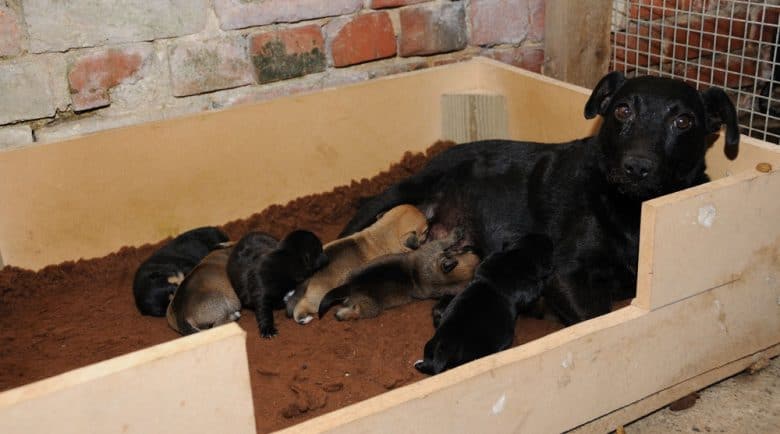
You could use your hands to feel the outside of the abdominal cavity gently. If there are any puppies left inside, you’ll be able to feel the shape.
Watch out for contractions or wave-like movements near its hind legs, and if the contractions have stopped, then your dog has finished giving birth.
You can also observe the dam’s behavior. If the mother is no longer panting, pacing, and whimpering and is now relaxing and resting with her puppies while they nurse, it’s another sign that the whelping is complete.
Whelping problems to watch out for
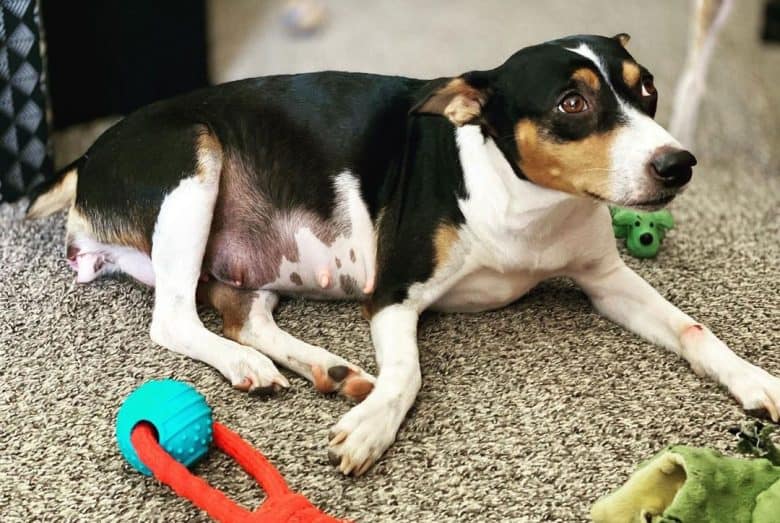
While the whelping process generally goes smoothly, there are a few potential complications you should prepare for.
Some are easily corrected with your intervention, while others may warrant a call to the Doctor of Veterinary Medicine (DVM) or vet.
Whether you’re a first-time dog breeder or not, familiarize yourself with any unusual scenarios should you be confronted with one. It’s also essential to keep your vet’s phone number on hand should emergencies arise.
Possible signs of whelping complications:
- Slightly green puppy placenta and discharge are normal but shouldn’t be very dark or excessive, and NOT before a pup is born.
- If the mother is sick or has a fever (over 103° degrees Fahrenheit).
- The mother hasn’t produced any puppies two days after her temperature dropped.
- Mother is actively straining or pushing, but there are no pups for 30-60 minutes or longer.
- You can see the puppy moving around or feel them vaginally, but mom’s labor isn’t progressive.
- If your female dog has been resting for over 3 hours, but you know or suspect there are still puppies that should come out.
- Labor hasn’t started after 65 days from the last breeding.
- The mother seems exhausted or unhappy.
- The mother is having forceful but intermittent contractions.
Whelping problems: What complications might there be?
Monitor the mother’s temperature and behavior. Call for veterinary assistance if something feels off.
Some of the most common health problems surrounding pregnancy and labor include Uterine Inertia or when the mother fails to produce contractions during whelping.
Dystocia or “difficult birth” includes a range of scenarios. Breeds prone to this condition, such as Bulldogs and Boston Terriers, should consider a c-section with the vet weeks before the due date.
Eclampsia, also called “Milk Fever,” is a rare but severe complication where high blood pressure causes seizures during pregnancy. When the pups are five days old, start feeding the dam calcium for the next few weeks.
Mastitis is an inflammation of the breast tissue that causes pain, swelling, warmth, and redness of the breast area.
And then there’s Metritis, the inflammation of the endometrium caused by a bacterial infection and usually occurs within the first week after whelping.
Frequently Asked Questions about Whelping Puppies (FAQs)

Does “morning sickness” occur in pregnant dogs?
Hormone changes during pregnancy can cause morning sickness in some dogs. But only for a few days in the third or fourth week. Your dam may have a fluctuating appetite and appear dissatisfied with her meals.
My dog has not had puppies before. Will she be alright when left alone while whelping?
Most dogs can whelp by themselves, although first-time moms may be more nervous and may whelp for longer. As mentioned, it’s best to keep a close eye on them for any complications.
How are puppies normally born? Do they usually come out backward?
Puppies are usually born inside a thin sac or membrane that either emerges head-first or tail-first — both are normal. But if they come out backward, make sure to get them out as soon as possible so they don’t suffocate.
Is it important to count the afterbirths?
Since most dogs will eat the afterbirth soon after delivery, it may be tricky to count them accurately. If the afterbirth isn’t passed, it will disintegrate between 24 and 48 hours after delivery, usually through defecation.
If the mother has smelly or bloody vaginal discharge during this time, seek help from your vet.
I have heard that some female dogs will have a puppy that is still attached to the afterbirth, then would run away and leave it. If this happens, what should I do?
This scenario can happen with first-time mothers, but only occasionally. Since the puppy is born in a fluid-filled membrane, make sure that the puppy’s mouth and nostrils are clear from any afterbirth.
What should I do if the puppy is visible, but it’s stuck, and my dog can’t deliver it?
If the puppy emerges head-first, remove the membranes from the visible face and mouth area. If they emerge backward, it’s considered a medical emergency.
Get the puppy out immediately before they suffocate.
Will puppies die if they are not stimulated immediately after birth?
If a puppy is born within the fetal sac that’s intact, it won’t be able to breathe. It should be removed either by the dam or by you.
If the mother doesn’t lick the puppy to stimulate breathing, use a clean towel to rub them clean yourself.
Can puppies drown in their own fetal fluids?
If puppies try to breathe while still in the sac, they can drown in their own fetal fluids as it enters their lungs. This is considered a medical emergency. You’ll need to ensure the sacs are broken.
Can puppies get too warm?
If the dam is nursing her puppies, it will be unnecessary to continue the heat source since this can cause overheating. You can instead use a thermometer to determine the right temperature before making adjustments to the heat.
Should I be worried about whelping puppies?
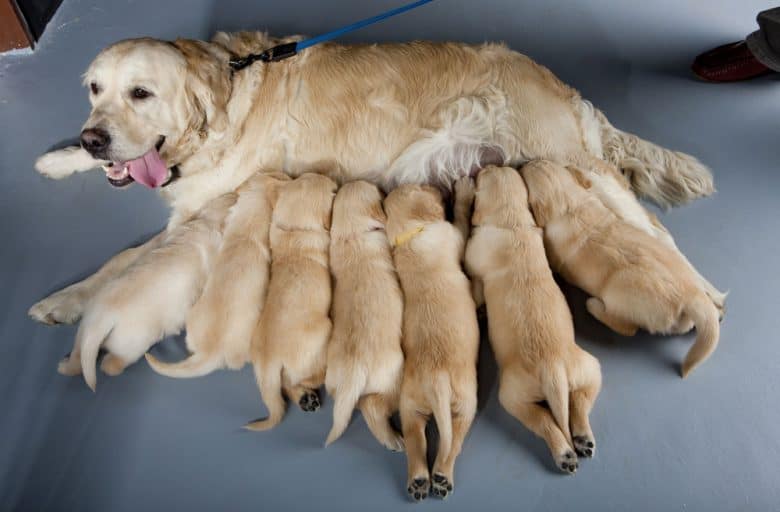
Whelping puppies is no small feat, especially for first-time whelpers. There’s a lot to prepare for, from potential complications to a long list of puppy whelping supplies.
But with the proper knowledge, you will be ready to welcome your dam’s new pups into the world in no time.
If you’re new to puppy whelping or feel unsure about the process, you should contact your veterinarian for professional advice.
Have any whelping tips to share with us? Feel free to leave a comment down below.
Cess is the Head of Content Writing at K9 Web and a passionate dog care expert with over 5 years of experience in the Pet Industry. With a background in animal science, dog training, and behavior consulting, her hands-on experience and extensive knowledge make her a trusted source for dog owners.
When not writing or leading the K9 Web content team, Cess can be found volunteering at local shelters and participating in dog-related events.
